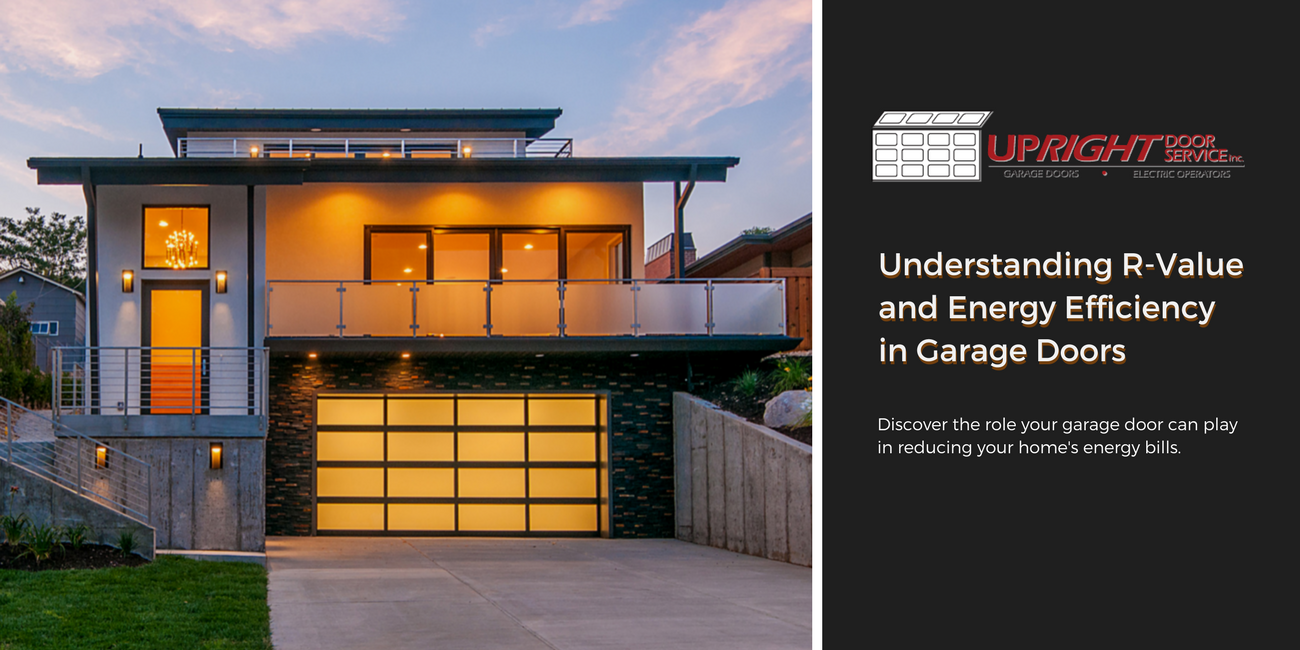R-Value. Heat conductors. Energy consumption. Thermal resistance.
These terms and many more affect the energy efficiency of your home.
In your effort to save money, lower energy usage, and leave a smaller carbon footprint, have you ever considered the role your garage door can play in reducing energy bills?
Did you know that your garage door can be the largest contributing source of heat and energy loss for your home?
How Your Garage Door Causes Energy Loss
First you need to know what the major causes of energy loss are in your garage door:
⇒Heat transfer
⇒Air leakage
⇒Infiltration
Steel and aluminum are conductors of energy and have low thermal resistance. Unless your steel garage door has some sort of insulation, it will act as a heat conductor. And considering the garage door is the largest door on your home, it’s a significant one at that!
Outside temperatures penetrate into the garage and from there, into the ceilings and walls of surrounding living spaces attached. A comfortable, stable climate in the garage and the rest of your home cannot be achieved when hot and cold temperatures easily transfer through the door. This heat transfer, air leakage, and infiltration affects the overall energy efficiency of your home.
[custom_blockquote style=”red”] Your non-insulated garage door is a significant heat conductor that transfers to the outdoors the heated or conditioned air that your appliances have worked hard to maintain![/custom_blockquote]
Construction of Insulated Garage Doors vs Non-Insulated Garage Doors
A non-insulated garage door consists of a single layer of steel and is open on the back (interior of the garage).
An insulated door is constructed with two layers of steel with insulation between each layer. The type and level of insulation can vary. They tend to be sturdier, thicker doors that are less prone to dents.
[custom_blockquote style=”red”]The goal for your garage door is to have it hold heat inside during the winter and radiate hot air away from the door in the summer. Consider upgrading to an insulated garage door if your budget allows.[/custom_blockquote]
The 2 Most Common Types of Garage Door Insulation
The two most used types of garage door insulation are polystyrene and polyurethane.
Polystyrene:
- Inserts between 2 outer steel walls of the garage door.
- Bonds to the inner walls of the wall of the steel door.
- Is made of the same material as packing material, craft material and styrofoam cups.
Polyurethane:
- A spray foam that adheres to both walls of garage door.
- Offers more coverage and results in a more flexible, sturdier door.
- Is an industry favourite.
- Is more environmentally friendly.
- Insulates better, has higher R-Value and is twice as effective (inch per inch) than polystyrene.
There are varying degrees of insulation for a garage door. This is where the term R-Value comes in. Watch this C.H.I. Video on the Value of Insulated Garage Doors
What is R-Value?
Construction and building industries use a standard measurement to establish different construction materials’ resistance to heat transfer. R-Value is this measurement of thermal resistance. Manufacturers use R-values to indicate the energy efficiency of their product.
Understanding R-Value Numbers
To begin, the chemical properties, the type of material, and its density determine the R-Value number. A material (such as insulation) is rated with a low R-value number and is not considered to be very thermal resistant if it allows heat or cold to pass through quickly and easily. The more insulating properties a material has, the higher the R-value number. For example, R-16 has better insulating properties than R-8. See R-Value Comparisons Chart below.
| Insulation R-Value | Amount of heat flow reduction | Improvement in Energy Efficiency vs R-8 Insulation |
| R-8 | 90% | – |
| R-12 | 93% | 3% |
| R-16 | 95% | 5% |
| R-20 | 96% | 6% |
| R-32 | 97% | 7% |
Note: An R-32 does not offer twice as much thermal resistance or twice the energy savings of an R-16 value. This chart indicates that an R-32 offers 7% reduction in heat transfer (and a 7% energy efficiency improvement) over an R-16 – not 50%. Chart source: Amarr Garage Doors – The Truth About R-Values 2013.
What else affects the R-Value of a garage door?
Yet there are are other factors to consider besides insulation when it comes to the R-Value and energy efficiency of a garage door. If a door doesn’t have proper thermal break system, and weather seal system between the door sections and around all four sides of the door, the door’s R-value can mean very little. To ensure your garage is as energy efficient as possible check for:
- Proper threshold seal from the bottom of the garage door to the floor.
- Insulation in rest of garage (ceiling, side, etc).
- Flexible weatherstriping/bottom weather seal (link to existing weatherstripping blog).
Determining the Right R-Value For Your Garage Door
Determine the appropriate R-Value for your garage door by considering the climate you live in and what your use your garage for .
- Garage detached and unheated? Use garage door that is lightly insulated (up to R-6) or non-insulated.
- Is garage attached to house? Use at least R-10 insulation.
- Garage used to house your vehicle during the winter and the rest of the time it’s used for storage? Use R-10.
- Is garage heated, insulated and temperature kept between 8-10 degrees? Use R-12 or more.
- Using garage as another living/working space like office or gym? Use R-16 or more.
[custom_blockquote style=”red”]Make sure windows are energy efficient as well if you are purchasing a new garage door with windows.[/custom_blockquote]
The Benefits of an Insulated Garage Door and Garage
To begin, an insulated garage and garage door (no matter what R-value it possesses) reduces the following:
- Noise levels: An insulated garage and garage door is a quieter garage. The noises that the door produces as it operates can be heard less inside adjoining rooms in the house.
- Heat flow: Whether you reside in a hot or cold climate, or anything in between, an insulated garage door and insulated garage walls moderate and maintain temperature levels in the garage and the adjoining rooms of the home – helping to keep house warm in winter and cool in summer.
- Energy costs/energy consumption: An insulated garage helps to maintain stable temperatures throughout the house and therefore lowers demand on heating and air conditioning units. For example in winter months, the furnace will not have to work as hard to heat the room above the garage. Thus consumption costs are lowered and energy efficiency of the home increases.
Additionally, an insulated garage door provides these benefits:
- Sturdier/more durable garage door: Insulation adds rigidity to the door panels. The higher the R-value, the stronger and more durable a garage door is. Insulated doors have a higher resistance to dents.
- Protects contents of garage, especially your vehicle: Cold outdoor temperatures put strain on your vehicle (dead batteries, frozen lines, low air pressure in tires, etc). Storing your vehicle inside your insulated garage puts less strain on the vehicle. Insulated garage doors keep temperatures in the garage above freezing and help to maintain the temperature of the garage. Furthermore, the garage also becomes a more stable environment for your other items that you store in it, such as cleaning supplies.
Other Ways To Increase Energy Efficiency of Your Garage
Finally, don’t stop with simply insulating your garage door. Further increase the energy efficiency of your garage and ultimately the rest of your home by:
- Sealing up the gaps.
- Insulating the floor and walls.
- Upgrading to energy efficient lighting and appliances.
- Adding solar panels.
So, install an insulated garage door and save money on your power bills throughout the year. It’s one of the most cost-effective ways to increase the energy efficiency of your home.
Contact us today to learn more about the garage doors we offer and to receive a free quote.
Connect with us on Facebook and Twitter for more tips.
Save
Save
Save


